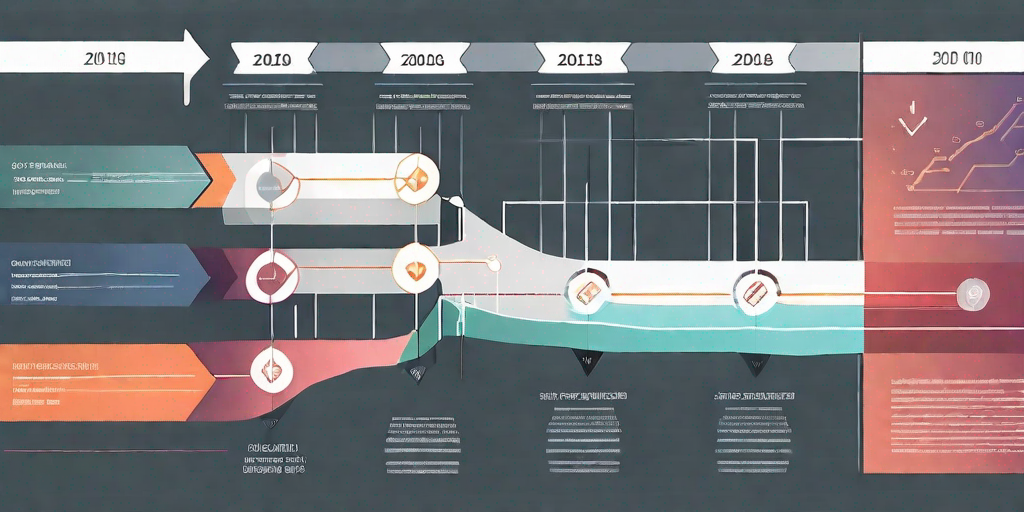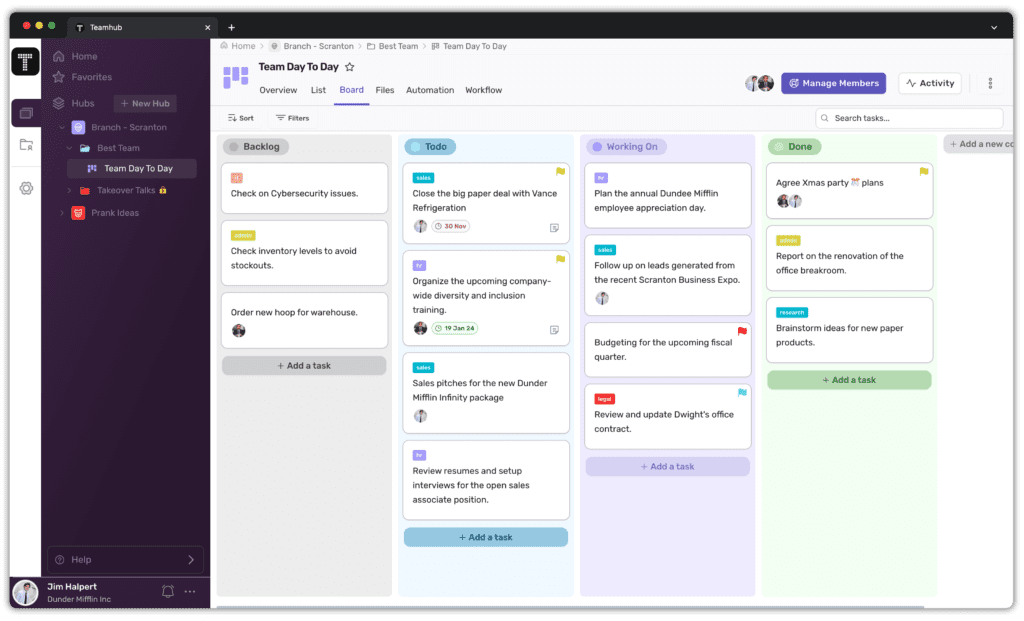LIMITED TIME OFFER
Replace all of these

with a single tool for just $1 per month for your entire team
UNLIMITED USERS
UNLIMITED PROJECTS
UNLIMITED CHATS
UNLIMITED DOCS
UNLIMITED STORAGE
AND MORE..
Variance at Completion (VAC) Explained

In the world of project management, having a clear understanding of various performance metrics is crucial for ensuring project success. One such important metric is Variance at Completion (VAC). In this article, we will delve into the concept of VAC, its importance, components, calculation process, and how it can be effectively used in forecasting project performance. So, let’s start by understanding the concept of Variance at Completion.

Understanding the Concept of Variance at Completion
Before diving deep into VAC, let’s first define what it actually means.
Variance at Completion, commonly abbreviated as VAC, is a project management metric that provides insights into the overall cost performance of a project at its completion. It is used to assess the variance between the planned budget and the estimated budget at the completion of a project.
When a project is initiated, a budget is allocated to cover all the expenses associated with its completion. However, as the project progresses, there may be deviations from the initial plan, resulting in changes in costs. These changes can be due to various factors such as unexpected delays, scope changes, resource constraints, or unforeseen risks.
The variance at completion metric helps project managers understand the extent of these changes and their impact on the project’s financial performance. By comparing the planned budget with the estimated budget at completion, project managers can identify whether the project is over budget or under budget.
Importantly, VAC is not just a measure of cost deviation; it also serves as an indicator of project efficiency. A positive VAC indicates that the project is under budget, meaning that the project team has managed to complete the work at a lower cost than initially planned. On the other hand, a negative VAC suggests that the project is over budget, indicating that the project team has exceeded the planned budget.
Understanding the importance of VAC in project management is crucial for effective cost control and decision-making. By regularly monitoring and analyzing VAC, project managers can identify potential cost overruns or savings early on and take appropriate actions to keep the project on track.
Moreover, VAC provides project stakeholders, such as clients, sponsors, and executives, with valuable information about the project’s financial health. It enables them to assess the project’s performance and make informed decisions regarding resource allocation, funding, and future investments.
Overall, variance at completion is a powerful tool that helps project managers assess the financial performance of a project and make informed decisions to ensure its successful completion within the allocated budget. By understanding and utilizing VAC effectively, project managers can enhance cost control, mitigate risks, and optimize project outcomes.
Importance of Variance at Completion in Project Management
VAC is a critical metric in project management as it allows project managers to evaluate the project’s financial health and make informed decisions regarding cost management. By comparing the planned budget with the estimated budget at completion, project managers can identify variances and take proactive measures to mitigate potential risks and control project costs effectively.
Unlock Efficiency with Teamhub

Components of Variance at Completion
Variance at Completion (VAC) is a key metric used in project management to assess the financial performance of a project. It provides valuable insights into the project’s budget and helps project managers make informed decisions. VAC comprises two essential components that form the basis of its calculation:
Budget at Completion (BAC)
Budget at Completion, also known as BAC, is a fundamental component of VAC. It refers to the sum of all planned costs for completing a project. In simpler terms, it represents the total estimated budget required for the successful execution of a project. The BAC is determined during the project planning phase and serves as a baseline against which the project’s financial performance is measured.
When determining the BAC, project managers take into account various factors such as labor costs, material costs, equipment costs, and any other expenses associated with the project. By considering all these elements, the BAC provides a comprehensive estimate of the project’s total cost.
Estimate at Completion (EAC)
Estimate at Completion, commonly referred to as EAC, is another crucial component of VAC. It represents the projected total cost of completing a project at its current stage. EAC takes into account the actual costs incurred up to a certain point and incorporates any adjustments or variations that have occurred during the project’s execution.
The EAC is calculated by considering the project’s performance to date and making predictions about future performance. It takes into account any changes in scope, schedule, or resource requirements that may have impacted the project’s cost. By incorporating these adjustments, the EAC provides a more accurate estimate of the project’s final cost.
Project managers use the EAC to assess the project’s financial health and make necessary adjustments to ensure its successful completion. It helps them identify potential cost overruns or savings and take appropriate actions to keep the project on track.
In conclusion, the components of Variance at Completion, namely the Budget at Completion (BAC) and Estimate at Completion (EAC), play a crucial role in evaluating the financial performance of a project. By understanding these components and their significance, project managers can effectively monitor and control project costs, ensuring successful project delivery.
Calculating Variance at Completion
Calculating Variance at Completion (VAC) is an important step in project management as it helps project managers assess the cost performance of a project. By determining the difference between the Budget at Completion (BAC) and the Estimate at Completion (EAC), project managers can gain valuable insights into the project’s financial status and make informed decisions.

The process of calculating VAC involves several steps that project managers need to follow:
Step-by-step Process
1. Obtain the Budget at Completion (BAC) value: The BAC represents the total budget allocated for the project. It includes all the planned costs for completing the project, including labor, materials, and overhead expenses.
2. Determine the Estimate at Completion (EAC) value: The EAC represents the projected total cost of completing the project. It takes into account the actual costs incurred so far, as well as the remaining work and any anticipated changes in scope or budget.
3. Subtract the EAC value from the BAC value to calculate the Variance at Completion (VAC): The VAC indicates the difference between the planned budget (BAC) and the projected budget (EAC) at the completion of the project. A positive VAC indicates that the project is under budget, while a negative VAC suggests that the project is over budget.
By calculating VAC, project managers can assess the financial health of the project and take appropriate actions to address any deviations from the planned budget.
Necessary Tools and Techniques
To accurately calculate VAC, project managers can rely on various tools and techniques that facilitate the process and provide valuable insights into project cost performance:
1. Financial management software: Project management software with built-in financial management capabilities can help project managers track and manage project costs effectively. These tools allow for easy input of budgeted and actual costs, and automatically calculate key financial metrics such as VAC.
2. Spreadsheets: Many project managers use spreadsheets, such as Microsoft Excel, to perform calculations and analyze project costs. Spreadsheets provide flexibility and customization options, allowing project managers to create formulas and charts to visualize cost data.
3. Earned Value Management (EVM) methodologies: EVM is a project management technique that integrates scope, schedule, and cost performance measurements. By using EVM, project managers can track the progress of work and compare it to the planned budget, enabling them to calculate VAC accurately.
These tools and techniques not only streamline the calculation process but also provide real-time insights into project cost performance. By leveraging these resources, project managers can make data-driven decisions and take proactive measures to ensure project success.
Interpreting Variance at Completion Results
Interpreting Variance at Completion (VAC) results is a crucial aspect of project management. It goes beyond simply calculating the variances; it involves understanding the implications and taking appropriate actions based on the results. Let’s delve deeper into how positive and negative variances impact project performance:
Positive Variance
When a project exhibits a positive VAC, it signifies that the actual costs incurred so far are lower than the estimated costs at completion. This positive variance is an encouraging sign for project managers as it indicates that the project is performing better than initially anticipated in terms of cost management.
With a positive VAC, project managers have the opportunity to make informed decisions regarding the remaining budget. They can allocate the surplus funds to other project activities, invest in additional resources, or even create a contingency fund for unforeseen circumstances. This flexibility allows project managers to optimize the project’s performance and deliver even greater value to stakeholders.
Negative Variance
Conversely, a negative VAC implies that the actual costs incurred are higher than the estimated costs at completion. This negative variance raises concerns about the project’s cost management and requires immediate attention from project managers.
When faced with a negative VAC, project managers must proactively identify the root causes of the variance. This involves conducting a detailed analysis of the underlying issues that contributed to the cost overrun. By understanding the factors that led to the negative variance, project managers can develop effective corrective actions to bring the project back on track.
Implementing corrective actions may involve revising the project’s budget, reevaluating resource allocation, renegotiating contracts, or even redefining project scope. It is crucial for project managers to collaborate with stakeholders and team members to ensure that the necessary measures are implemented promptly and effectively.
Furthermore, a negative VAC serves as a valuable learning opportunity for project managers. It highlights areas where cost management strategies can be improved, and lessons can be learned for future projects. By analyzing the causes of the negative variance and implementing corrective actions, project managers can enhance their skills and knowledge in cost management, ultimately leading to more successful projects in the future.
In conclusion, interpreting VAC results is not just about understanding the numbers; it is about comprehending the implications and taking appropriate actions. Positive variances provide project managers with opportunities for optimization, while negative variances necessitate swift corrective actions. By effectively managing variances, project managers can ensure the successful delivery of projects within budget and meet stakeholders’ expectations.
The Role of Variance at Completion in Forecasting
Beyond assessing the project’s performance, VAC plays a vital role in forecasting project outcomes and assisting in effective decision-making. Let’s explore how it serves as a valuable tool for project forecasting:
Predicting Project Performance

Based on the analysis of historical cost performance and the calculated VAC, project managers can make informed predictions about the project’s future performance. This allows them to anticipate potential risks, plan resource allocation, and adjust project schedules and budgets accordingly.
Risk Management and Mitigation
By continuously monitoring the VAC, project managers can identify potential risks early on and implement risk mitigation strategies to avoid cost overruns or delays. Keeping a close eye on VAC empowers project managers to proactively address emerging issues and maintain control over project finances.
In conclusion, Variance at Completion (VAC) is a critical metric in project management that facilitates effective cost control, risk management, and informed decision-making. By understanding the concept, components, and calculation process of VAC, project managers can assess project performance, interpret the results, and harness the power of VAC in forecasting future outcomes. Incorporate VAC into your project management arsenal and unlock the key to successful project execution and financial management.


